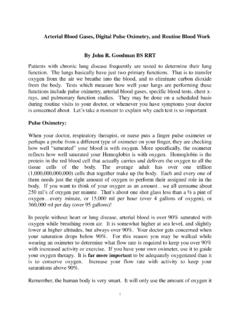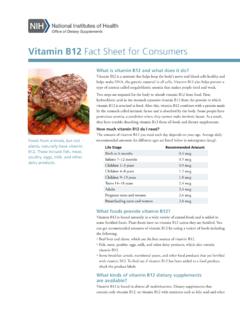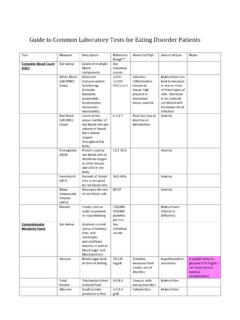Transcription of Why does my oxygen saturation drop when I get up and move ...
1 1 Why does my oxygen saturation drop when I get up and move around? By: John R. Goodman BS RRT In last month s article I introduced the term Hypoxic Club. As a quick review, there are literally hundreds of diseases, conditions, or situations where a person s oxygen saturation (Sa02) drops below the (more or less) universally recognized 90% figure. If your Sa02 indeed does drop into the 80 s you would be considered hypoxic, and therefore you have gained membership in the Hypoxic Club. Hypoxia is the medical term that simply describes the fact that blood levels of oxygen are below normal. We do need to differentiate between a little bit acute hypoxic situations, and chronic hypoxic situations.
2 Denver looking west Mt. Evans as seen from The road to the top of Denver of Mt. Evans. As I sit at my computer on the south side of Denver, Colorado, the mile high city really is located at 5280 feet. The beautiful mountains of Colorado are just an hour or so west of Denver. There is one mountain in particular that has a paved road all the way to its summit, and before the snows of winter close the road, it is an easy drive all the way to the top. This is Mt. Evans (Elv. 14,270 feet) and it is one of Colorado s 54 mountains that are over 14,000 feet.
3 What do you think the oxygen saturation is at the top of Mt Evans in perfectly healthy people??? It averages 82%! Does this meet our definition of hypoxia? Do (thousands) of visitors a year join the Hypoxic Club? This is what I mean by acute hypoxia. For a little bit better understanding, I am going to use just one oxygen saturation number to show what happens at eight different altitudes. Absolute sea level Prairies and the plains Mt. town at 10,350 ft Altitude oxygen saturation 2 Sea Level 97% 5000 ft. 94% 10,000 ft. 90% 12,000 ft.
4 87% Highest city in the world 13,000 ft. 84% Potosi, Bolivia 13,420 feet 14,000 ft. 82% 15,000 ft. 80% 20,000 ft. 67% Mt. Everest 57% (29,029 ft.) Mt. Everest So you can see that anyone, even the most athletic, can become temporary members of the Hypoxic Club. We see this fairly often in some borderline patients who have had major surgery. They may need supplemental oxygen for a few months at home.
5 Many studies have documented how many patients like this come off oxygen by about 3 months after their surgery. So, these patients do not become card carrying members of the Hypoxic club. There is also some controversy over how often to reevaluate patients once started on LTOT. It seems that unofficially, blood oxygen levels are to be measured at 90 days initially and yearly thereafter. In reality, follow-up re-evaluations are all over the map. Some studies have suggested that up to 60% of patients initially started on oxygen may not need to be on oxygen upon re-evaluation. Where the rubber meets the road is the fact that the majority of these studies only take into account the resting oxygen saturation value.
6 Your activity or exercise saturation levels are rarely measured. If at rest your saturations hold pretty steady in the 90 s, but just standing up drops you into the 80 s or absolutely need to be on oxygen . How about a little physiology lesson? 3 The most recent estimate on how many cells there are in the body is one hundred trillion (100,000,000,000,000). Every one of those cells requires a tiny, tiny amount of oxygen to function at their best. So tiny an amount, that all hundred trillion cells consume just 250 cc of oxygen per minute. Now that s what I call efficiency. It is the primary job of the lung to bring in enough oxygen from the air we breathe to ensure a constant and fresh supply to each and every cell.
7 Each cell of the body is like a mini energy production factory. The chief architect of energy production in the cell is called the Mitochondria. The Mitochondria are responsible for taking in the oxygen delivered by the circulation, and through a series of very complex roll and store the energy we need to go about our daily activities. Mitochondria in Provide And energy! Muscle cell I guess it s pretty obvious to say that the most important of our daily activities is breathing. That means our lungs have to bring in enough oxygen to keep those powerhouses supplied with enough oxygen to accomplish whatever we ask them to do.
8 If we assume that your blood flow is intact and the delivery van is running, then it s a matter of loading enough oxygen molecules to be delivered to the billions of muscle cells that are involved in the simple act of taking a breath, much less taking a step. It may not be a direct relationship, but common sense says if you want to do more of any physical need to exert more muscular effort. That means the Mitochondria need more fuel ( oxygen ) to produce more energy to accomplish the task. Yes there might be more vans on the road as your heart rate begins to rise, but each van will have less oxygen in it as it passes more quickly through the lungs for pickup.
9 So now you can begin to see the dilemma presented to your body. I have always told my patients it s not just a Catch-22, it s a Catch-44! The more you want to do, the more oxygen you need to do it. Those billions of muscle cells don t really know you have lung disease. All they know is for some reason they are not getting the normal amount of fuel they usually get. And boy do they let you know, right! ( I will take some time in an upcoming article of the month to explain in more 4 detail what is going on at the cell level.) For now, let s stay with what you already know. As your oxygen saturation falls, and your heart rate increases, you feel short of breath, fatigued, and usually the need to take a rest to recover.
10 Remember, it may take a few minutes for your oximeter to record both the drop in saturation , and it s return to the normal range. This can happen when you simply stand up, go from the kitchen to the bathroom, walk out to the mailbox, take a shower, tie your shoes, brush your hair, stand at the stove to cook a list is very long. The rest of the Catch-44 is that in reality, no two patients react the same way to this situation. There are other confounding factors, disorders, or diseases that contribute to the complexity of energy production. Rapidly dropping saturations with even minimal activity is a hallmark of patients with Interstitial Lung Disease.








